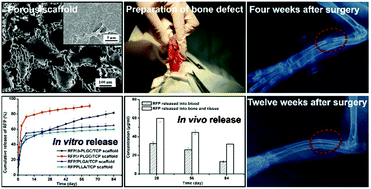In vitro and in vivo drug release behavior and osteogenic potential of a composite scaffold based on poly(ε-caprolactone)-block-poly(lactic-co-glycolic acid) and β-tricalcium phosphate
Abstract
To cure serious bone tuberculosis, a novel long-term drug delivery system was designed and prepared to satisfy the needs of both bone regeneration and antituberculous drug therapy. An antituberculous drug (rifampicin, RFP) was loaded into a porous scaffold, which composed of a newly designed polylactone, poly(ε-caprolactone)-block-poly(lactic-co-glycolic acid) (b-PLGC) copolymer, and β-tricalcium phosphate (β-TCP). The releasing results demonstrated that RFP could be steadily released for as long as 12 weeks both in vitro and in vivo. During the in vivo experimental period, the drug concentration in tissues surrounding implants was much higher than that in blood which was still superior to the effective value to kill mycobacterium tuberculosis. MC3T3-E1 osteoblasts proliferated well in extracts and co-cultures on composite scaffolds, indicating good cytocompatibility and cell affinity of the scaffolds. The results of a rabbit radius repair experiment displayed that scaffolds have good bone regeneration capacity. The RFP-loaded b-PLGC/TCP composite scaffold thus could be envisioned to be a potential and promising substrate in clinical treatment of bone tuberculosis.


 Please wait while we load your content...
Please wait while we load your content...